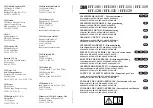
Functions
2.16 Backup Time Overcurrent Protection
SIPROTEC, 7SD5, Manual
C53000-G1176-C169-5, Release date 02.2011
309
2.16.3
Setting Notes
General
During configuration of the scope of functions for the device (address
126
) the available characteristics were
determined. Depending on the configuration and the order variant, only those parameters that apply to the se-
lected characteristics are accessible in the procedures described below.
If the differential protection and the distance protection operate in parallel in the protection relay, emergency
operation will not be activated unless both protection functions have become ineffective. If only one of the two
protection functions fails, the other protection function can provide complete protection of the object, so that
emergency operation is not yet required in such a case.
Emergency operation is activated if only one of the protection functions (address
115
,
116
and
117
=
Disabled
or address
112
DIFF.PROTECTION
=
Disabled
) was configured and has become ineffective.
Address
2601
is set according to the desired mode of operation of the time overcurrent protection:
Operating
Mode
=
ON
means that time overcurrent protection operates independently of the other protection functions, i.e.
as a backup time overcurrent protection. If it is intended to work only as an emergency function in case of a
transmission and/or voltage failure, set
Only Emer. prot
. Finally, it can also be set to
OFF
.
If not all stages are required, each individual stage can be deactivated by setting the pickup threshold to
∞
. But
if you set only an associated time delay to
∞
this does not suppress the pickup signals but prevents the timers
from running.
The
I
>>> stage is effective even if the operating mode of the time overcurrent protection has been set to
Only
Emer. prot
and
„>I-STUB ENABLE“
is released.
One or several stages can be set as instantaneous tripping stages when switching onto a fault. This is chosen
during the setting of the individual stages (see below). To avoid a spurious pick-up due to transient overcur-
rents, the delay
SOTF Time DELAY
(address
2602
) can be set. Typically, the presetting of
0
s is correct. A
short delay can be useful in case of long cables for which high inrush currents can be expected, or for trans-
formers. This delay depends on the intensity and the duration of the transient overcurrents as well as on which
stages were selected for the fast switch onto fault clearance.
High-current Stages
I
ph
>>, 3
I
0
>>
The
I
>> stages
Iph>>
(address
2610
) and
3I0>> PICKUP
(address
2612
) together with the
I
> stages or the
I
p
stages form a two-stage characteristic curve. Of course, all three stages can be combined as well. If one
stage is not required, the pickup value has to be set to
∞
. The
I
>> stages always operate with a defined delay
time.
If the
I
>> stages are used for instantaneous tripping before the automatic reclosure (via CFC interconnection),
the current setting corresponds to the
I
> or
I
p
stages (see below). In this case, only the different delay times
are of interest. The times
T Iph>>
(address
2611
) and
T 3I0>>
(address
2613
) can then be set to
0
s or a
very low value, as the fast clearance of the fault takes priority over the selectivity before the automatic reclosure
is initiated. These stages have to be blocked before final trip in order to achieve the selectivity.
For very long lines with a small source impedance or on applications with large reactances (e.g. transformers,
series reactors), the
I
>> stages can also be used for current grading. In this case, they must be set in such a
way that they do not pick up in case of a fault at the end of the line. The times can then be set to
0
s or to a
small value.
When using a personal computer and DIGSI to apply the settings, these can be optionally entered as primary
or secondary values. For settings with secondary values the currents will be converted for the secondary side
of the current transformers.













































